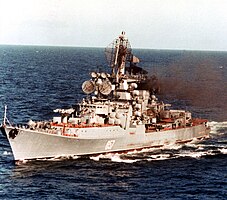Kresta II class
|
Project 1134A cruiser Admiral Yumashev , 1982
|
||||||||||||||
|
||||||||||||||
|
||||||||||||||
|
||||||||||||||
|
||||||||||||||
Project 1134A Berkut A , designated by NATO as the Kresta II class , was a class of guided missile cruisers of the Soviet and later Russian navies . They were based on Project 1134 , the main design difference was the incorporation of anti-submarine weapons instead of anti-ship missiles .
history
The first ship from Project 1134A was laid down in late 1966. In contrast to the previous version Kresta I, the ships of the Kresta II class were designed even more for anti-submarine warfare. This is believed to have been another response to the development of the Polaris submarine-based ICBMs . The two double starters for anti-ship guided missiles of the type P-35 (NATO code: SS-N-3 "Shaddock") were replaced by two quadruple starters for anti-submarine missiles of the type UPRK-3 "Metel" (NATO Code: SS-N-14 "Silex") replaced. Apparently there were initially discussions in the Soviet Navy about whether instead of anti-submarine missiles, anti-ship missiles of the P-15 “Termit” (NATO code: SS-N-2 “Styx”) or P -120 "Malachite" (NATO code: SS-N-9 "Siren") should be installed. However, it was decided to use the anti-submarine missiles, which were new at the time.
Construction differences
Armament
The main difference in armament was the replacement of the P-35 anti-ship missile (NATO code: SS-N-3 "Shaddock") with the UPRK-3 Metel anti-submarine missile (NATO Code: SS-N-14 "Silex"). With the UPRK-3 submarines can be fought up to a distance of 50 kilometers. This is done by means of a missile that drops a torpedo or a nuclear depth charge in the target area.
Furthermore, the systems for the naval version of the Issajew S-125 Neva (NATO code: "SA-3 Goa") were replaced by systems for the anti -aircraft missiles of the M-11 Schtorm type (NATO code: SA-N-3 "Goblet" ) replaced. The main advantage of the M-11 Schtorm was its greater range, which was now 30 km. The more modern missiles can even be used up to a range of 55 km. Up to 72 missiles of this type could be carried on the ships of the Kresta II class.
In addition, four six-barrel Gatling guns of the type AK-630 were installed as CIWS . They have an effective range of 3,000–4,000 m and a cadence of 2,000–4,000 rounds / min.
Dimensions and drive
The hull remained essentially unchanged, it was only lengthened by 2 m. The maximum water displacement increased only slightly as a result. The propulsion systems remained the same as in the Kresta I-Class, and accordingly the top speed of around 34 knots . The range also remained at around 10,400 nautical miles at an ideal speed of 14 knots .
Operational readiness
All units in the class were withdrawn from active service shortly after the end of the Cold War . At least six units have already been scrapped and not much is known about the condition of the four remaining units.
Evidence and references
literature
- С.С. Бережной: Советский ВМФ 1945–1995 Крейсера - большие противолодочные корабли, эсминцы. (For example: SS Bereschnoi: Soviet Navy 1945–1995 cruisers, large submarine fighters, destroyers. ) Moscow 1995.
Web links
- The Kresta II class on fas.org (English)
